| Revision as of 00:29, 3 January 2015 view sourceElekhh (talk | contribs)Autopatrolled, Extended confirmed users, Pending changes reviewers28,070 edits Undid revision 640725873 by Nikolaserbboy1995 (talk) prose preferred to lists and no flagicons← Previous edit | Revision as of 02:20, 3 January 2015 view source Nikolaserbboy1995 (talk | contribs)102 editsNo edit summaryNext edit → | ||
| Line 152: | Line 152: | ||
| Under the Nazi regime, 65,000 Jewish people were deported and murdered in concentration camps by Nazi forces; approximately 130,000 fled.<ref>{{cite web|url=https://www.jewishvirtuallibrary.org/jsource/judaica/ejud_0002_0020_0_20409.html |title=Vienna |publisher=Jewishvirtuallibrary.org |accessdate=19 May 2012}}</ref> | Under the Nazi regime, 65,000 Jewish people were deported and murdered in concentration camps by Nazi forces; approximately 130,000 fled.<ref>{{cite web|url=https://www.jewishvirtuallibrary.org/jsource/judaica/ejud_0002_0020_0_20409.html |title=Vienna |publisher=Jewishvirtuallibrary.org |accessdate=19 May 2012}}</ref> | ||
| ethnic groups 2014 | |||
| By 2001, 16% of people living in Austria had nationalities other than Austrian, nearly half of whom were from former ];<ref>{{cite web|url=http://www.statistik.at/web_de/static/bevoelkerung_2001_nach_umgangssprache_staatsangehoerigkeit_und_geburtsland_022896.pdf |title=Bevölkerung 2001 nach Umgangssprache, Staatsangehörigkeit und Geburtsland |format=PDF |accessdate=19 May 2012}}</ref><ref>{{cite web|url=http://www.dw-world.de/dw/article/0,,5096611,00.html?maca=ser-TB_ser_politka1-3157-html-cb |title=Beč: Božić na gastarbajterski način | Evropa | Deutsche Welle | 07.01.2010 |publisher=Dw-world.de |accessdate=22 January 2010}}</ref> the next most numerous nationalities in Vienna were ] (39,000; 2.5%), ] (13,600; 0.9%) and Germans (12,700; 0.8%).<ref name="census">{{cite book |url=ftp://www.statistik.at/pub/neuerscheinungen/vz01wien_web.pdf |format=PDF |publisher=Statistik Austria |year=2003 |title=Volkszählung. Hauptergebnisse I – Wien |language=German |accessdate=23 September 2011}}</ref> | |||
| *{{flag|Serbia}}: 70.810 | |||
| *{{flag|Turkey}}: 44.816 | |||
| *{{flag|Germany}}: 37.982 | |||
| *{{flag|Poland}}: 34.993 | |||
| *{{flag|Bosnia and Herzegovina}}: 20.410 | |||
| *{{flag|Romania}}: 20.050 | |||
| *{{flag|Croatia}}: 18.789 | |||
| *{{flag|Hungary}}: 14.263 | |||
| *{{flag|Russia}}: 12.986 | |||
| *{{flag|Slovakia}}: 12.046 | |||
| As of 2012, an official report from Statistics Austria showed that more than 660,000 (38.8%) of the Viennese population have full or partial migrant background, mostly from Czech Republic, Slovakia, Hungary, ex-Yugoslavia, Turkey and Germany.<ref name="statistik.at" /><ref name="wien.gv.at" /> This is reflected today in the telephone list of the city where there is an eclectic list of surnames. | As of 2012, an official report from Statistics Austria showed that more than 660,000 (38.8%) of the Viennese population have full or partial migrant background, mostly from Czech Republic, Slovakia, Hungary, ex-Yugoslavia, Turkey and Germany.<ref name="statistik.at" /><ref name="wien.gv.at" /> This is reflected today in the telephone list of the city where there is an eclectic list of surnames. | ||
Revision as of 02:20, 3 January 2015
"Wien" redirects here. For other uses, see Wien (disambiguation). This article is about the capital of Austria. For other uses, see Vienna (disambiguation).Place in Austria
| Vienna Wien | |
|---|---|
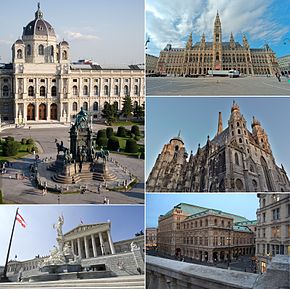 From top, left to right: Kunsthistorisches Museum, City Hall, St. Stephen's Cathedral, Vienna State Opera, and Austrian Parliament Building From top, left to right: Kunsthistorisches Museum, City Hall, St. Stephen's Cathedral, Vienna State Opera, and Austrian Parliament Building | |
 Flag Flag Seal Seal Coat of arms Coat of arms | |
| Country | |
| State | Vienna |
| Government | |
| • Mayor and Governor | Michael Häupl (SPÖ) |
| • Vice-Mayor and Vice-Governor | Maria Vassilakou (Grüne), Renate Brauner (SPÖ); |
| Area | |
| • City | 414.65 km (160.10 sq mi) |
| • Land | 395.26 km (152.61 sq mi) |
| • Water | 19.39 km (7.49 sq mi) |
| Elevation | 151 (Lobau) – 542 (Hermannskogel) m (495–1,778 ft) |
| Population | |
| • City | 1,793,667 |
| • Density | 4,002.2/km (10,366/sq mi) |
| • Metro | ca. 2,419,000 |
| • Ethnicity | 61.2% Austrian 38.8% Other |
| Statistik Austria, VCÖ – Mobilität mit Zukunft | |
| Demonym(s) | Viennese, Wiener |
| Time zone | UTC+1 (CET) |
| • Summer (DST) | UTC+2 (CEST) |
| Vehicle registration | W |
| Website | www.wien.gv.at |
| UNESCO World Heritage Site | |
|---|---|
| Criteria | Cultural: ii, iv, vi |
| Reference | 1033 |
| Inscription | 2001 (25th Session) |
Vienna (/viːˈɛnə/; Template:Lang-de) is the capital and largest city of Austria, and one of the nine states of Austria. Vienna is Austria's primary city, with a population of about 1.757 million (2.4 million within the metropolitan area, more than 20% of Austria's population), and its cultural, economic, and political centre. It is the 7th-largest city by population within city limits in the European Union. Until the beginning of the 20th century it was the largest German-speaking city in the world, and before the splitting of the Austro-Hungarian Empire in World War I the city had 2 million inhabitants. Today it is the second only to Berlin in German speakers. Vienna is host to many major international organizations, including the United Nations and OPEC. The city lies in the east of Austria and is close to the borders of the Czech Republic, Slovakia, and Hungary. These regions work together in a European Centrope border region. Along with nearby Bratislava, Vienna forms a metropolitan region with 3 million inhabitants. In 2001, the city centre was designated a UNESCO World Heritage Site.
Apart from being regarded as the City of Music because of its musical legacy, Vienna is also said to be "The City of Dreams" because it was home to the world's first psycho-analyst – Sigmund Freud. The city's roots lie in early Celtic and Roman settlements that transformed into a Medieval and Baroque city, the capital of the Austro-Hungarian Empire. It is well known for having played an essential role as a leading European music centre, from the great age of Viennese Classicism through the early part of the 20th century. The historic centre of Vienna is rich in architectural ensembles, including Baroque castles and gardens, and the late-19th-century Ringstrasse lined with grand buildings, monuments and parks.
In a 2005 study of 127 world cities, the Economist Intelligence Unit ranked the city first (in a tie with Vancouver, Canada) for the world's most livable cities (in the 2012 survey of 140 cities Vienna was ranked number two, behind Melbourne). For four consecutive years (2009–2012), the human-resource-consulting firm Mercer ranked Vienna first in its annual "Quality of Living" survey of hundreds of cities around the world, a title the city has reclaimed in 2014. Monocle's 2012 "Quality of Life Survey" ranked Vienna fourth on a list of the top 25 cities in the world "to make a base within" (up from sixth in 2011 and eighth in 2010).
The city was ranked 1st globally for its culture of innovation in 2007 and 2008, and fifth globally (out of 256 cities) in the 2011 Innovation Cities Index, which analyzed 162 indicators in covering three areas: culture, infrastructure, and markets. Vienna regularly hosts urban planning conferences and is often used as a case study by urban planners. Between 2005 and 2010, Vienna was the world's number one destination for international congresses and conventions. It attracts about five million tourists a year.
Name
See also Other names of ViennaThe English name Vienna is borrowed from the Italian name Vienna. "Vienna" and the official German name Wien, and the names of the city in most languages, are thought to be derived from the Celtic word "windo-", meaning bright or fair – as in the Irish "fionn" and the Welsh "gwyn" – but opinions vary on the precise origin. Some claim that the name comes from Vedunia, meaning "forest stream," which subsequently became Venia, Wienne and Wien. Others claim that the name comes from the Roman settlement of Celtic name Vindobona (Celtic "windo-bona"), probably meaning "white base/bottom ," which became Vindovina, Vídeň (Czech) and Wien.
The name of the city in Hungarian (Bécs), Serbian and Croatian (Beč) and Ottoman Turkish (Beç) appears to have a different, Slavonic origin, and originally referred to an Avar fort in the area. In Slovene, the city is called Dunaj, which in other Slavic languages means the Danube River, on which it is located.
History
Main articles: History of Vienna and Timeline of ViennaEarly history


Evidence has been found of continuous habitation since 500 BC, when the site of Vienna on the Danube River was settled by the Celts. In 15 BC, the Romans fortified the frontier city they called Vindobona to guard the empire against Germanic tribes to the north.
Close ties with other Celtic peoples continued through the ages. The Irish monk Saint Colman (or Koloman, Irish Colmán, derived from colm "dove") is buried in Melk Abbey and Saint Fergil (Virgil the Geometer) was Bishop of Salzburg for forty years, and twelfth-century monastic settlements were founded by Irish Benedictines. Evidence of these ties is still evident in Vienna's great Schottenstift monastery, once home to many Irish monks.

In 976, Leopold I of Babenberg became count of the Eastern March, a 60-mile district centering on the Danube on the eastern frontier of Bavaria. This initial district grew into the duchy of Austria. Each succeeding Babenberg ruler expanded the march east along the Danube eventually encompassing Vienna and the lands immediately east. In 1145, Duke Henry II Jasomirgott moved the Babenberg family residence from Klosterneuburg to Vienna. Since that time, Vienna remained the center of the Babenberg dynasty.
In 1440, Vienna became the resident city of the Habsburg dynasty. It eventually grew to become the de facto capital of the Holy Roman Empire (1483–1806) and a cultural centre for arts and science, music and fine cuisine. Hungary occupied the city between 1485–1490.
In the 16th and 17th centuries, the Ottoman armies were stopped twice outside Vienna (see Siege of Vienna, 1529 and Battle of Vienna, 1683). A plague epidemic ravaged Vienna in 1679, killing nearly a third of its population.
Austro-Hungarian Empire

In 1804, during the Napoleonic Wars, Vienna became the capital of the Austrian Empire and continued to play a major role in European and world politics, including hosting the Congress of Vienna in 1814/15. After the Austro-Hungarian Compromise of 1867, Vienna remained the capital of what was then the Austro-Hungarian Empire. The city was a centre of classical music, for which the title of the First Viennese School is sometimes applied.
During the latter half of the 19th century, the city developed what had previously been the bastions and glacis into the Ringstraße, a new boulevard surrounding the historical town and a major prestige project. Former suburbs were incorporated, and the city of Vienna grew dramatically. In 1918, after World War I, Vienna became capital of the Republic of German-Austria, and then in 1919 of the First Republic of Austria.
From the late 19th century to 1938, the city remained a centre of high culture and modernism. A world capital of music, the city played host to composers such as Brahms, Bruckner, Mahler and Richard Strauss. The city's cultural contributions in the first half of the 20th century included, among many, the Vienna Secession movement, psychoanalysis, the Second Viennese School, the architecture of Adolf Loos and the philosophy of Ludwig Wittgenstein and the Vienna Circle. In 1913, Adolf Hitler, Leon Trotsky, Joseph Tito, Sigmund Freud and Joseph Stalin all lived within a few miles of each other in central Vienna, with some of them being regulars at the same coffeehouses. Within Austria, Vienna was seen as a centre of socialist politics, for which it was sometimes referred to as "Red Vienna". The city was a stage to the Austrian Civil War of 1934, when Chancellor Engelbert Dollfuss sent the Austrian Army to shell civilian housing occupied by the socialist militia.
The Anschluss and World War II
Main article: AnschlussIn 1938, after a triumphant entry into Austria, Austrian-born Adolf Hitler spoke to the Austrian Germans from the balcony of the Neue Burg, a part of the Hofburg at the Heldenplatz. Between 1938 (after the Anschluss) and the end of the Second World War, Vienna lost its status as a capital to Berlin as Austria ceased to exist and became a part of Nazi Germany. It was not until 1955 that Austria regained full sovereignty.
On 2 April 1945, the Soviets launched the Vienna Offensive against the Germans holding the city and besieged it. British and American air raids and artillery duels between the SS and Wehrmacht and the Red Army crippled infrastructure, such as tram services and water and power distribution, and destroyed or damaged thousands of public and private buildings. Vienna fell eleven days later. Austria was separated from Germany, and Vienna was restored as the republic's capital city, but the Soviet hold on the city remained until 1955.
Four-power Vienna
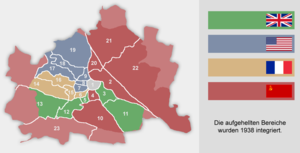
After the war, Vienna was part of Soviet-occupied Eastern Austria until September 1945. As in Berlin, Vienna in September 1945 was divided into sectors by the four powers: the USA, the UK, France and the Soviet Union and supervised by an Allied Commission. The four-power occupation of Vienna differed in one key respect from that of Berlin: the central area of the city, known as the first district, constituted an international zone in which the four powers alternated control on a monthly basis. The control was policed by the four powers on a de facto day-to-day basis, the famous "four soldiers in a jeep" method. The Berlin Blockade of 1948 raised allied concerns that the Soviets might repeat the blockade in Vienna. The matter was raised in the UK House of Commons:
What plans have the Government for dealing with a similar situation in Vienna? Vienna is in exactly a similar position to Berlin. It is surrounded by a Soviet Zone of occupation and we have our sector of responsibility in Vienna the same as the Americans and the French. What plans have the Government to deal with a similar situation arising in Vienna in the near future? I hope we shall have an answer, because this is of vital importance. – Sir Anthony Nutting, Honourable Member for Melton, 30 June 1948, House of Commons, London.
There was a lack of airfields in the Western sectors, and authorities drafted contingency plans to deal with such a blockade. Plans included the laying down of metal landing mats at Schönbrunn. The Soviets did not blockade the city. The Potsdam Agreement included written rights of land access to the western sectors, whereas no such written guarantees had covered the western sectors of Berlin. During the 10 years of the four-power occupation, Vienna became a hot-bed for international espionage between the Western and Eastern blocs. In the wake of the Berlin Blockade, the Cold War in Vienna took on a different dynamic. While accepting that Germany and Berlin would be divided, the Soviets had decided against allowing the same state of affairs to arise in Austria and Vienna. Here the Soviet forces controlled the districts 2, 4, 10, 20, 21 and 22 and all areas incorporated into Vienna in 1938.
They put up barbed wire fences around the perimeter of West Berlin in 1953, but not in Vienna. By 1955, the Soviets, by signing the State Treaty, agreed to relinquish their occupation zones in Eastern Austria as well as their sector in Vienna. In exchange they required that Austria declare its permanent neutrality after the allied powers had left the country. Thus they ensured that Austria would not be a member of NATO and that NATO forces would therefore not have direct communications between Italy and West Germany.
The atmosphere of four-power Vienna is the background for Graham Greene's screenplay for the film The Third Man (1949). Later he adapted the screenplay as a novel and published it. Occupied Vienna is also depicted in the Philip Kerr novel, A German Requiem.
Austrian State Treaty and afterwards
The four-power control of Vienna lasted until the Austrian State Treaty was signed in May 1955. That year, after years of reconstruction and restoration, the State Opera and the Burgtheater, both on the Ringstraße, reopened to the public. The Soviet Union signed the State Treaty only after having been provided with the political guarantee by the federal government to declare Austria's neutrality after the withdrawal of the allied troops. This law of neutrality, passed in late October 1955 (and not the State Treaty itself), ensured that modern Austria would align with neither NATO nor the Soviet bloc, and is considered one of the reasons for Austria's late entry into the European Union.
In the 1970s, Austrian Chancellor Bruno Kreisky inaugurated the Vienna International Centre, a new area of the city created to host international institutions. Vienna has regained much of its former international stature by hosting international organizations, such as the United Nations (United Nations Industrial Development Organization, United Nations Office at Vienna and United Nations Office on Drugs and Crime), the Preparatory Commission for the Comprehensive Nuclear-Test-Ban Treaty Organization, the International Atomic Energy Agency, the Organization of Petroleum Exporting Countries, and the Organization for Security and Cooperation in Europe and the United European Gastroenterology Federation.
Demographics
| Year | Pop. | ±% |
|---|---|---|
| 1754 | 175,460 | — |
| 1800 | 271,800 | +54.9% |
| 1850 | 551,300 | +102.8% |
| 1900 | 1,769,137 | +220.9% |
| 1910 | 2,083,630 | +17.8% |
| 1923 | 1,918,720 | −7.9% |
| 1939 | 1,770,938 | −7.7% |
| 1951 | 1,616,125 | −8.7% |
| 1961 | 1,627,566 | +0.7% |
| 1971 | 1,619,885 | −0.5% |
| 1981 | 1,535,145 | −5.2% |
| 1985 | 1,494,874 | −2.6% |
| 1990 | 1,492,636 | −0.1% |
| 1995 | 1,542,667 | +3.4% |
| 2000 | 1,548,537 | +0.4% |
| 2005 | 1,632,569 | +5.4% |
| 2010 | 1,689,995 | +3.5% |
| 2013 | 1,741,246 | +3.0% |
| 2014 | 1,793,667 | +3.0% |
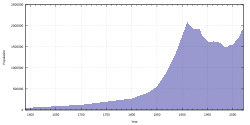
Because of the industrialization and migration from other parts of the Empire, the population of Vienna increased sharply during its time as the capital of Austria-Hungary (1867–1918). In 1910, Vienna had more than two million inhabitants, and was the fourth largest city in Europe after London, Paris and Berlin. Around the start of the 20th century, Vienna (Czech Vídeň, Hungarian Bécs, Slovak Viedeň) was the city with the second-largest Czech population in the world (after Prague). At the height of the migration, about one-third of the Viennese population was of Slavic or Hungarian origin. After World War I, many Czechs and Hungarians returned to their ancestral countries, resulting in a decline in the Viennese population. After World War II, the Soviets used force to repatriate key workers of Czech, Slovak and Hungarian origins to return to their ethnic homelands to further the Soviet bloc economy.
Under the Nazi regime, 65,000 Jewish people were deported and murdered in concentration camps by Nazi forces; approximately 130,000 fled.
ethnic groups 2014
 Serbia: 70.810
Serbia: 70.810 Turkey: 44.816
Turkey: 44.816 Germany: 37.982
Germany: 37.982 Poland: 34.993
Poland: 34.993 Bosnia and Herzegovina: 20.410
Bosnia and Herzegovina: 20.410 Romania: 20.050
Romania: 20.050 Croatia: 18.789
Croatia: 18.789 Hungary: 14.263
Hungary: 14.263 Russia: 12.986
Russia: 12.986 Slovakia: 12.046
Slovakia: 12.046
As of 2012, an official report from Statistics Austria showed that more than 660,000 (38.8%) of the Viennese population have full or partial migrant background, mostly from Czech Republic, Slovakia, Hungary, ex-Yugoslavia, Turkey and Germany. This is reflected today in the telephone list of the city where there is an eclectic list of surnames.
From 2002 to 2012 the city's population grew by over ten percent. In 2012 alone it added 25,000 people, making it the fastest growing city in German-speaking countries.
Geography and climate
Vienna is located in northeastern Austria, at the easternmost extension of the Alps in the Vienna Basin. The earliest settlement, at the location of today's inner city, was south of the meandering Danube while the city now spans both sides of the river. Elevation ranges from 151 to 524 m (495 to 1,719 ft).

Vienna lies within a transition of oceanic climate and humid continental climate, and features, according to the Köppen classification, a Cfb (oceanic) -climate. The city has warm summers with average high temperatures of 24 to 33 °C (75 to 91 °F), with maximum exceeding 38 °C (100 °F) and lows of around 15 °C (59 °F). Winters are relatively dry and cold with average temperatures at about freezing point. Spring and autumn are mild. Precipitation is generally moderate throughout the year, averaging 620 mm (24.4 in) annually, with considerable local variations, the Vienna Woods region in the west being the wettest part (700 to 800 mm (28 to 31 in) annually) and the flat plains in the east being the driest part (500 to 550 mm (20 to 22 in) annually). Snow in the winter is not uncommon, but rare compared to Western and Southern regions in Austria.
| Climate data for Vienna | |||||||||||||
|---|---|---|---|---|---|---|---|---|---|---|---|---|---|
| Month | Jan | Feb | Mar | Apr | May | Jun | Jul | Aug | Sep | Oct | Nov | Dec | Year |
| Record high °C (°F) | 16.7 (62.1) |
19.1 (66.4) |
25.5 (77.9) |
27.8 (82.0) |
30.7 (87.3) |
35.9 (96.6) |
36.0 (96.8) |
37.0 (98.6) |
31.1 (88.0) |
26.4 (79.5) |
20.8 (69.4) |
16.1 (61.0) |
37.0 (98.6) |
| Mean daily maximum °C (°F) | 2.9 (37.2) |
5.1 (41.2) |
10.3 (50.5) |
15.2 (59.4) |
20.5 (68.9) |
23.4 (74.1) |
25.6 (78.1) |
25.4 (77.7) |
20.3 (68.5) |
14.2 (57.6) |
7.5 (45.5) |
4.0 (39.2) |
14.5 (58.1) |
| Daily mean °C (°F) | 0.1 (32.2) |
1.6 (34.9) |
5.7 (42.3) |
10.0 (50.0) |
15.2 (59.4) |
18.2 (64.8) |
20.2 (68.4) |
19.8 (67.6) |
15.3 (59.5) |
9.9 (49.8) |
4.6 (40.3) |
1.5 (34.7) |
10.2 (50.4) |
| Mean daily minimum °C (°F) | −2.0 (28.4) |
−0.9 (30.4) |
2.4 (36.3) |
5.8 (42.4) |
10.5 (50.9) |
13.5 (56.3) |
15.4 (59.7) |
15.3 (59.5) |
11.7 (53.1) |
7.0 (44.6) |
2.4 (36.3) |
−0.5 (31.1) |
6.7 (44.1) |
| Record low °C (°F) | −18.9 (−2.0) |
−17.2 (1.0) |
−15.3 (4.5) |
−2.7 (27.1) |
1.0 (33.8) |
4.8 (40.6) |
8.4 (47.1) |
7.0 (44.6) |
3.1 (37.6) |
−4.5 (23.9) |
−9.6 (14.7) |
−18.1 (−0.6) |
−18.9 (−2.0) |
| Average precipitation mm (inches) | 37.2 (1.46) |
39.4 (1.55) |
46.1 (1.81) |
51.7 (2.04) |
61.8 (2.43) |
70.2 (2.76) |
68.2 (2.69) |
57.8 (2.28) |
53.5 (2.11) |
40.0 (1.57) |
50.0 (1.97) |
44.4 (1.75) |
620.3 (24.42) |
| Average snowfall cm (inches) | 18.6 (7.3) |
15.6 (6.1) |
8.3 (3.3) |
1.5 (0.6) |
0.0 (0.0) |
0.0 (0.0) |
0.0 (0.0) |
0.0 (0.0) |
0.0 (0.0) |
0.0 (0.0) |
7.9 (3.1) |
16.4 (6.5) |
68.3 (26.9) |
| Average precipitation days (≥ 1.0 mm) | 7.3 | 7.6 | 8.3 | 7.5 | 8.5 | 9.1 | 9.0 | 8.0 | 7.0 | 6.0 | 8.3 | 8.2 | 94.8 |
| Average snowy days (≥ 1.0 cm) | 13.9 | 10.0 | 4.0 | 0.4 | 0.0 | 0.0 | 0.0 | 0.0 | 0.0 | 0.0 | 2.7 | 8.3 | 39.3 |
| Mean monthly sunshine hours | 60.9 | 90.1 | 131.5 | 173.8 | 228.0 | 222.8 | 241.8 | 239.2 | 167.6 | 131.2 | 65.5 | 52.0 | 1,804.4 |
| Source: Central Institute for Meteorology and Geodynamics | |||||||||||||
Districts and enlargement
Main article: Districts of Vienna
Vienna is composed of 23 districts (Bezirke). Administrative district offices in Vienna (called Magistratische Bezirksämter) serve functions similar to those in the other states (called Bezirkshauptmannschaften), the officers being subject to the Landeshauptmann (which in Vienna is the mayor); with the exception of the police, which in Vienna is governed by the President of the Police (at the same time one of the nine Directors of Security of Austria), a federal office, directly responsible to the Minister of the Interior.
As had been planned in 1919 for all of Austria but not introduced, district residents in Vienna (Austrians as well as EU citizens with permanent residence here) elect a District Assembly (Bezirksvertretung), which chooses the District Head (Bezirksvorsteher) as political representative of the district on city level. City hall has delegated maintenance budgets, e.g., for schools and parks, so that they are able to set priorities autonomously. Any decision of a district can be overridden by the city assembly (Gemeinderat) or the responsible city councillor (amtsführender Stadrat).
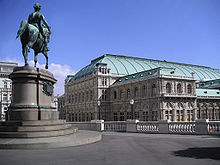
The heart and historical city of Vienna, a large part of today's Innere Stadt, was a fortress surrounded by fields in order to defend itself from potential attackers. In 1850, Vienna with the consent of the emperor annexed 34 surrounding villages, called Vorstädte, into the city limits (districts no. 2 to 8, after 1861 with the separation of Margareten from Wieden no. 2 to 9). Consequently the walls were razed after 1857, making it possible for the city centre to expand.
In their place, a broad boulevard called the Ringstraße was built, along which imposing public and private buildings, monuments, and parks were created by the start of the 20th century. These buildings include the Rathaus (town hall), the Burgtheater, the University, the Parliament, the twin museums of natural history and fine art, and the Staatsoper. It is also the location of New Wing of the Hofburg, the former imperial palace, and the Imperial and Royal War Ministry finished in 1913. The mainly Gothic Stephansdom is located at the centre of the city, on Stephansplatz. The Imperial-Royal Government set up the Vienna City Renovation Fund (Wiener Stadterneuerungsfonds) and sold many building lots to private investors, thereby partly financing public construction works.

From 1850 to 1890, city limits in the West and the South mainly followed another wall called Linienwall. Outside this wall from 1873 onwards a ring road called Gürtel was built. In 1890 it was decided to integrate 33 suburbs (called Vororte) beyond that wall into Vienna by 1 January 1892 and transform them into districts no. 11 to 19 (district no. 10 had been constituted in 1874); hence the Linienwall was torn down beginning in 1894. In 1900, district no. 20, Brigittenau, was created by separating the area from the 2nd district.
From 1850 to 1904, Vienna had expanded only on the right bank of the Danube, following the main branch before the regulation of 1868–1875, i.e., the Old Danube of today. In 1904, the 21st district was created by integrating Floridsdorf, Kagran, Stadlau, Hirschstetten, Aspern and other villages on the left bank of the Danube into Vienna, in 1910 Strebersdorf followed. On 15 October 1938 the Nazis created Great Vienna with 26 districts by merging 97 towns and villages into Vienna, 80 of which were returned to surrounding Lower Austria in 1954. Since then Vienna has 23 districts.
Industries are located mostly in the southern and eastern districts. The Innere Stadt is situated away from the main flow of the Danube, but is bounded by the Donaukanal ("Danube canal"). Vienna's second and twentieth districts are located between the Donaukanal and the Danube River. Across the Danube, where the Vienna International Centre is located, and in the southern areas are the newest parts of the city (districts 21–23).
Politics


In the twenty years before the First World War and until 1918, Viennese politics were shaped by the Christian Social Party, in particular long-term mayor Karl Lueger; he managed not to apply the general voting rights for men introduced by and for the parliament of imperial Austria, the Reichsrat, in 1907, thereby excluding most of the working class from taking part in decisions. For Adolf Hitler, who spent some years in Vienna, Lueger was a remarkable teacher of how to use antisemitism in politics.
Vienna is today considered the centre of the Social Democratic Party of Austria. During the period of the First Republic (1918–1934), the Vienna Social Democrats undertook many overdue social reforms. At that time, Vienna's municipal policy was admired by Socialists throughout Europe, who therefore referred to the city as "Red Vienna" (Rotes Wien). In February 1934 troops of the Conservative Austrian federal government under Engelbert Dollfuss, who had closed down the first chamber of the federal parliament, the Nationalrat, in 1933, and paramilitary socialist organisations were engaged in the Austrian civil war, which led to the ban of the Social Democratic party.
For most of the time since after the First World War, the city has been governed by the Social Democratic Party (SPÖ) with absolute majorities in the city parliament. Only between 1934 and 1945, when the Social Democratic Party was illegal, mayors were appointed by the austro-fascist and later by the Nazi authorities. The current mayor of Vienna is Michael Häupl of the SPÖ. As rural Austria is dominated by conservative citizens, if the Social Democrats would not maintain their nearly unbreakable hold on Vienna, the rival Austrian People's Party (ÖVP) would dominate Austrian politics.
The city has enacted many social democratic policies. The Gemeindebauten are social housing assets that are well integrated into the city architecture outside the first or "inner" district. The low rents enable comfortable accommodation and good access to the city amenities. Many of the projects were built after WW II on vacant lots that were destroyed by bombing during the war. The city took particular pride in building them to a high standard.
Since Vienna obtained federal state (Bundesland) status of its own by the federal constitution of 1920, the mayor (except 1934–1945) also holds the function of the state governor (Landeshauptmann). The Rathaus accommodates the offices of the mayor (Magistrat der Stadt Wien) and the state government (Landesregierung). The city is administered by a multitude of departments (Magistratsabteilungen), politically supervised by amtsführende Stadträte (members of the city government leading offices; according to the Vienna constitution opposition parties have the right to designate members of the city government not leading offices).
In the 1996 City Council election, the SPÖ lost its overall majority in the 100-seat chamber, winning 43 seats and 39.15% of the vote. In 1996 the Freedom Party of Austria (FPÖ), which won 29 seats (up from 21 in 1991), beat the ÖVP into third place for the second time running. From 1996–2001, the SPÖ governed Vienna in a coalition with the ÖVP. In 2001 the SPÖ regained the overall majority with 52 seats and 46.91% of the vote; in October 2005 this majority was increased further to 55 seats (49.09%). In course of the 2010 city council elections the SPÖ lost their overall majority again and consequently forged a coalition with the Green Party – the first SPÖ/Green coalition in Austria.
Religion
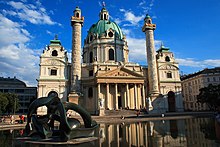

Vienna is the seat of the Roman Catholic Archdiocese of Vienna; its current Archbishop is Cardinal Christoph Schönborn. According to the 2001 census, 49.2% of Viennese were Roman Catholics, while 25.7% were of no religion, 7.8% were Muslim, 6.0% were members of an Orthodox denomination, 4.7% were Protestant (mostly Lutheran), 0.5% were Jewish, and 6.3% were either of other religions or did not reply. In 2011 the shares of religious bodies have significantly changed:
- 41.3 % Roman Catholics
- 31.6 % no religion
- 11.6% Muslim
- 8.4% Orthodox
- 4.2% Protestant
- 2.9% others
Many Roman Catholic churches in central Vienna feature performances of religious or other music, including masses sung to classical music and organ. Some of Vienna's most significant historical buildings are Roman Catholic churches, including the St. Stephen's Cathedral (Stephansdom), Karlskirche, Peterskirche, and the Votivkirche.
The proportion of Viennese who identify as Roman Catholic has dropped over the last fifty years, from 90% in 1961 to 39.8% in 2010.
On the banks of the Danube, there is a Buddhist Peace Pagoda, built in 1983 by the monks and nuns of Nipponzan Myohoji.
Culture
Music, theatre and opera
See also: Music of Austria and Vienna State Opera Ballet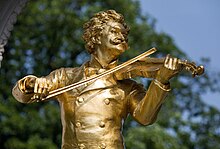
Music is one of Vienna's legacies. Musical prodigies including Wolfgang Amadeus Mozart, Joseph Haydn, Ludwig van Beethoven, Franz Schubert, Johannes Brahms, Gustav Mahler and Arnold Schoenberg have worked there.
Art and culture had a long tradition in Vienna, including theatre, opera, classical music and fine arts. The Burgtheater is considered one of the best theatres in the German-speaking world alongside its branch, the Akademietheater. The Volkstheater Wien and the Theater in der Josefstadt also enjoy good reputations. There is also a multitude of smaller theatres, in many cases devoted to less mainstream forms of the performing arts, such as modern, experimental plays or cabaret.

Vienna is also home to a number of opera houses, including the Theater an der Wien, the Staatsoper and the Volksoper, the latter being devoted to the typical Viennese operetta. Classical concerts are performed at world famous venues such as the Wiener Musikverein, home of the Vienna Philharmonic Orchestra known across the world for the annual widely broadcast "New Year's Day Concert", also the Wiener Konzerthaus. Many concert venues offer concerts aimed at tourists, featuring popular highlights of Viennese music, particularly the works of Wolfgang Amadeus Mozart, Johann Strauss the father, and Johann Strauss the son.

Up until 2005, the Theater an der Wien has hosted premieres of musicals, although with the year of the Mozart celebrations 2006 it has devoted itself to the opera again and has since become a stagione opera house offering one new production each month, thus quickly becoming one of Europe's most interesting and advanced opera houses. Since 2012 Theater an der Wien has taken over the Wiener Kammeroper, a historical small theatre in the first district of Vienna seating 300 spectators, turning it into its second venue for smaller sized productions and chamber operas created by the young ensemble of Theater an der Wien (JET). Before 2005 the most successful musical by far was "Elisabeth", which was later translated into several languages and performed all over the world. The Wiener Taschenoper is dedicated to stage music of the 20th and 21st century. The Haus der Musik ("house of music") opened in the year 2000.
The Wienerlied is a unique song genre from Vienna. There are approximately 60,000 – 70,000 Wienerlieder.
In 1981 the popular British new romantic group Ultravox paid a tribute to Vienna on an album and an artful music video recording called "Vienna". The inspiration for this work arose from the cinema production called "The Third Man" with the title Zither music of Anton Karas.
The Vienna's English Theatre (VET) is an English theater in Vienna. It was founded in 1963 and is located in the 8th Vienna's district. It is the oldest English-language theater in Europe outside the UK.
In May 2015, Vienna will be the host city for the 60th Annual Eurovision Song Contest following Austria's victory in the 2014 contest.
Musicians from Vienna
Notable musicians were born in Vienna, including: Franz Schubert, Johann Strauss I, Johann Strauss II, Arnold Schönberg, Fritz Kreisler, Alban Berg, Anton Webern, Louie Austen, Falco and Joe Zawinul.
Famous musicians who came here to work from other parts of Austria and Germany were Johann Joseph Fux, Joseph Haydn, Wolfgang Amadeus Mozart, Ludwig van Beethoven, Antonio Salieri, Carl Czerny, Johann Nepomuk Hummel, Franz Liszt, Franz von Suppé, Anton Bruckner, Johannes Brahms, Gustav Mahler and Rainhard Fendrich.
Museums

The Hofburg is the location of the Imperial Treasury (Schatzkammer), holding the imperial jewels of the Habsburg dynasty. The Sisi Museum (a museum devoted to Empress Elisabeth of Austria) allows visitors to view the imperial apartments as well as the silver cabinet. Directly opposite the Hofburg are the Kunsthistorisches Museum, which houses many paintings by old masters, ancient and classical artifacts, and the Naturhistorisches Museum.
A number of museums are located in the Museumsquartier (museum quarter), the former Imperial Stalls which were converted into a museum complex in the 1990s. It houses the Museum of Modern Art, commonly known as the MUMOK (Ludwig Foundation), the Leopold Museum (featuring the largest collection of paintings in the world by Egon Schiele, as well as works by the Vienna Secession, Viennese Modernism and Austrian Expressionism), the AzW (museum of architecture), additional halls with feature exhibitions, and the Tanzquartier. The Liechtenstein Palace contains much of one of the world's largest private art collections, especially strong in the Baroque. Castle Belvedere, built under Prinz Eugen, has a gallery containing paintings by Gustav Klimt (The Kiss), Egon Schiele, and other painters of the early 20th century, also sculptures by Franz Xaver Messerschmidt, and changing exhibitions too.
There are a multitude of other museums in Vienna, including the Albertina, the Military History Museum, the Technical Museum, the Burial Museum, the Museum of Art Fakes, the KunstHausWien, the Sigmund Freud Museum, and the Mozarthaus Vienna. The museums on the history of the city, including the former Historical Museum of the City of Vienna on Karlsplatz, the Hermesvilla, the residences and birthplaces of various composers, the Museum of the Romans, and the Vienna Clock Museum, are now gathered together under the group umbrella Vienna Museum. In addition there are museums dedicated to Vienna's individual districts. They provide a record of individual struggles, achievements and tragedy as the city grew and survived two world wars. For readers seeking family histories these are good sources of information.
Architecture
See also: Category:Buildings and structures in Austria
A variety of architectural styles can be found in Vienna, such as the Romanesque Ruprechtskirche and the Baroque Karlskirche. Styles range from classicist buildings to modern architecture. Art Nouveau left many architectural traces in Vienna. The Secession, Karlsplatz Stadtbahn Station, and the Kirche am Steinhof by Otto Wagner rank among the best known examples of Art Nouveau in the world.
Concurrent to the Art Nouveau movement was the Wiener Moderne, during which some architects shunned the use of extraneous adornment. A key architect of this period was Adolf Loos, whose works include the Looshaus (1909), the Kärntner Bar or American Bar (1908) and the Steiner House (1910).
The Hundertwasserhaus by Friedensreich Hundertwasser, designed to counter the clinical look of modern architecture, is one of Vienna's most popular tourist attractions. Another example of unique architecture is the Wotrubakirche by sculptor Fritz Wotruba. In the 1990s, a number of quarters were adapted and extensive building projects were implemented in the areas around Donaustadt (north of the Danube) and Wienerberg (in southern Vienna).
The 220-meter high DC Tower 1 located on the Northern bank of the Danube, completed in 2013, is the talltest skyscraper in Vienna. In recent years, Vienna has seen numerous architecture projects completed which combine modern architectural elements with old buildings, such as the remodelling and revitalisation of the old Gasometer in 2001. Most buildings in Vienna are relatively low; in early 2006 there were around 100 buildings higher than 40 m. The number of high-rise buildings is kept low by building legislation aimed at preserving green areas and districts designated as world cultural heritage. Strong rules apply to the planning, authorisation and construction of high-rise buildings. Consequently, much of the inner city is a high-rise free zone.
Vienna balls
Vienna is the last great capital of the nineteenth-century ball. There are over 200 significant balls per year, some featuring as many as nine live orchestras. Balls are held in the many beautiful palaces in Vienna, with the principal venue being the Hofburg Palace at Heldenplatz. While the Opera Ball is the best known internationally of all the Austrian balls, other balls such as the Kaffeesiederball (Cafe Owners Ball), the Jägerball (Hunter's Ball) or the Life Ball (AIDS Charity Event) are almost as well known within Austria and even better appreciated for their cordial atmosphere. Viennese of at least middle class may visit a number of balls in their lifetime. For many, the ball season lasts three months and can include up to ten or fifteen separate appearances.
Dancers and opera singers from the Vienna Staatsoper often perform at the openings of the larger balls.
A Vienna ball is an all-night cultural attraction. Major Viennese balls generally begin at 9 pm and last until 5 am, although many guests carry on the celebrations into the next day.
 Panoramic view Vienna at night
Panoramic view Vienna at night

Education
Vienna is Austria's main centre of education and home to many universities, professional colleges and gymnasiums (high schools).
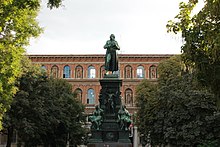
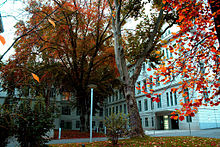

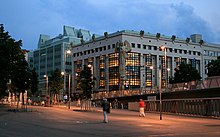
Universities
- Academy of Fine Arts Vienna
- Diplomatic Academy of Vienna
- Medical University of Vienna
- PEF Private University of Management Vienna
- University of Applied Arts Vienna
- University of Music and Performing Arts, Vienna
- University of Veterinary Medicine Vienna
- University of Vienna
- Vienna University of Economics and Business
- University of Natural Resources and Life Sciences, Vienna
- Vienna University of Technology
- Webster University Vienna
- Sigmund Freud University Vienna
- International Anti-Corruption Academy (in Laxenburg, 24 km (15 mi) south of Vienna)
International schools
- Danube International School
- International University Vienna
- SAE Vienna
- Lauder Business School
- Lycée Français de Vienne
- Vienna Christian School
- Vienna International School
- American International School
Leisure activities
Parks and gardens
 Panoramic view of park in Donaustadt
Panoramic view of park in Donaustadt

Vienna possesses many parks, including the Stadtpark, the Burggarten, the Volksgarten (part of the Hofburg), the Schlosspark at Schloss Belvedere (home to the Vienna Botanic Gardens), the Donaupark, the Schönbrunner Schlosspark, the Prater, the Augarten, the Rathauspark, the Lainzer Tiergarten, the Dehnepark, the Resselpark, the Votivpark, the Kurpark Oberlaa, the Auer-Welsbach-Park and the Türkenschanzpark. Green areas include Laaer-Berg (including the Bohemian Prater) and the foothills of the Wienerwald, which reaches into the outer areas of the city. Small parks, known by the Viennese as Beserlparks, are everywhere in the inner city areas.
Many of Vienna's famous parks include monuments, such as the Stadtpark with its statue of Johann Strauss II, and the gardens of the baroque palace, where the State Treaty was signed. Vienna's principal park is the Prater which is home to the Riesenrad, a Ferris wheel. The imperial Schönbrunn's grounds contain an 18th-century park which includes the world's oldest zoo, founded in 1752. The Donauinsel, part of Vienna's flood defences, is a 21.1 km (13.1 mi) long artificial island between the Danube and Neue Donau dedicated to leisure activities.
Sport

Austria's capital is home to numerous football teams. The best known are the local football clubs include FK Austria Wien (21 Austrian Bundesliga titles and record 27-time cup winners), SK Rapid Wien (record 32 Austrian Bundesliga titles), and the oldest team, First Vienna FC. Other important sports clubs include the Raiffeisen Vikings Vienna (American Football), who won the Eurobowl title between 2004 and 2007 4 times in a row and had a perfect season in 2013, the Aon hotVolleys Vienna, one of Europe's premier Volleyball organisations, the Vienna Wanderers (baseball) who won the 2012 and 2013 Championship of the Austrian Baseball League, and the Vienna Capitals (Ice Hockey). Vienna was also where the European Handball Federation (EHF) was founded. There are also three rugby clubs; Vienna Celtic, the oldest rugby club in Austria, RC Donau, and Stade Viennois
Vienna hosts many different sporting events including the Vienna City Marathon, which attracts more than 10,000 participants every year and normally takes place in May. In 2005 the Ice Hockey World Championships took place in Austria and the final was played in Vienna. Vienna's Ernst Happel Stadium was the venue of four Champions League and European Champion Clubs' Cup finals (1964, 1987, 1990 and 1995) and on 29 June it hosted the final of Euro 2008 which saw a Spanish 1–0 victory over Germany.
Culinary specialities
Food
See also: Austrian cuisine
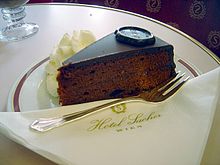
Vienna is well known for Wiener Schnitzel, a cutlet of veal (Kalbs Schnitzel) or pork (Schweins Schnitzel) that is pounded flat, coated in flour, egg and breadcrumbs, and fried in clarified butter. It is available in almost every restaurant that serves Viennese cuisine and can be eaten hot or cold. Other examples of Viennese cuisine include Tafelspitz (very lean boiled beef), which is traditionally served with Geröstete Erdäpfel (boiled potatoes mashed with a fork and subsequently fried) and horseradish sauce, Apfelkren (a mixture of horseradish, cream and apple) and Schnittlauchsauce (a chives sauce made with mayonnaise and stale bread).
Vienna has a long tradition of producing the finest cakes and desserts. These include Apfelstrudel (hot apple strudel), Milchrahmstrudel (milk-cream strudel), Palatschinken (sweet pancakes), and Knödel (dumplings) often filled with fruit such as apricots (Marillenknödel). Sachertorte, a delicately moist chocolate cake with apricot jam created by the Sacher Hotel, is world famous.
In winter, small street stands sell traditional Maroni (hot chestnuts) and potato fritters.
Sausages are popular and available from street vendors (Würstelstand) throughout the day and into the night. The sausage known as Wiener (German for Viennese) in the U.S. and in Germany, is in Vienna called a Frankfurter. Other popular sausages are Burenwurst (a coarse beef and pork sausage, generally boiled), Käsekrainer (spicy pork with small chunks of cheese), and Bratwurst (a white pork sausage). Most can be ordered "mit Brot" (with bread) or as a "hot dog" (stuffed inside a long roll). Mustard is the traditional condiment and usually offered in two varieties: "süß" (sweet) or "scharf" (spicy).
Kebab and pizza are, increasingly, the snack foods most widely available from small stands.
The Naschmarkt is a permanent market for fruit, vegetables, spices, fish, meat, etc., from around the world. The city has many coffee and breakfast stores.
Drinks
Vienna, along with Paris, Prague, Bratislava, Warsaw and London, is one of the few remaining world capital cities with its own vineyards. The wine is served in small Viennese pubs known as Heuriger, which are especially numerous in the wine growing areas of Döbling (Grinzing, Neustift am Walde, Nußdorf, Salmannsdorf, Sievering), Floridsdorf (Stammersdorf, Strebersdorf), Liesing (Mauer) and Favoriten (Oberlaa). The wine is often drunk as a Spritzer ("G'spritzter") with sparkling water. The Grüner Veltliner, a dry white wine, is the most widely cultivated wine in Austria.
Beer is next in importance to wine. Vienna has a single large brewery, Ottakringer, and more than ten microbreweries. A "Beisl" is a typical small Austrian pub, of which Vienna has many.
Viennese cafés

Viennese cafés have an extremely long and distinguished history that dates back centuries, and the caffeine addictions of some famous historical patrons of the oldest are something of a local legend. These coffee houses are unique to Vienna and many cities have unsuccessfully sought to copy them. Traditionally, the coffee comes with a glass of water. Viennese cafés claim to have invented the process of filtering coffee from booty captured after the second Turkish siege in 1683. Viennese cafés claim that when the invading Turks left Vienna, they abandoned hundreds of sacks of coffee beans. The Polish King Jan III Sobieski, the commander of the anti-Turkish coalition of Poles, Germans, and Austrians, gave Franz George Kolschitzky (Polish – Franciszek Jerzy Kulczycki) some of this coffee as a reward for providing information that allowed him to defeat the Turks. Kolschitzky then opened Vienna's first coffee shop. Julius Meinl set up a modern roasting plant in the same premises where the coffee sacks were found, in 1891.
Tourist attractions
Further information: Tourist attractions in ViennaMajor tourist attractions include the imperial palaces of the Hofburg and Schönbrunn (also home to the world's oldest zoo, Tiergarten Schönbrunn) and the Riesenrad in the Prater. Cultural highlights include the Burgtheater, the Wiener Staatsoper, the Lipizzaner horses at the spanische Hofreitschule, and the Vienna Boys' Choir, as well as excursions to Vienna's Heurigen district Döbling.
 Schönbrunn Palace
Schönbrunn Palace
 Gloriette at the Schönbrunn Palace
Gloriette at the Schönbrunn Palace
There are also more than 100 art museums, which together attract over eight million visitors per year. The most popular ones are Albertina, Belvedere, Leopold Museum in the Museumsquartier, KunstHausWien, BA-CA Kunstforum, the twin Kunsthistorisches Museum and Naturhistorisches Museum, and the Technisches Museum Wien, each of which receives over a quarter of a million visitors per year.
There are many popular sites associated with composers who lived in Vienna including Beethoven's various residences and grave at Zentralfriedhof (Central Cemetery) which is the largest cemetery in Vienna and the burial site of many famous people. Mozart has a memorial grave at the Habsburg gardens and at St. Marx cemetery (where his grave was lost). Vienna's many churches also draw large crowds, famous of which are St. Stephen's Cathedral, the Deutschordenskirche, the Jesuitenkirche, the Karlskirche, the Peterskirche, Maria am Gestade, the Minoritenkirche, the Ruprechtskirche, the Schottenkirche, St. Ulrich and the Votivkirche.
Modern attractions include the Hundertwasserhaus, the United Nations headquarters and the view from the Donauturm.
-
Albertina
-
 Austrian Parliament Building
Austrian Parliament Building
-
 Belvedere Palace
Belvedere Palace
-
 Graben
Graben
-
 Kunsthistorisches Museum
Kunsthistorisches Museum
-
 Naturhistorisches Museum
Naturhistorisches Museum
-
 Palais Augarten
Palais Augarten
-
 Rathaus
Rathaus
-
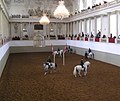 Spanish Riding School
Spanish Riding School
-
St. Stephen's Cathedral
-
 Stephansplatz
Stephansplatz
-
 Vienna Secession building
Vienna Secession building
-
Vienna State Opera
-
 Wiener Riesenrad
Wiener Riesenrad
Transportation

Vienna has an extensive transportation network with a unified fare system that integrates municipal, regional and railway systems under the umbrella of the Verkehrsverbund Ost-Region (VOR). Public transport is provided by buses, trams and 5 underground metro lines (U-Bahn). Trains are operated by the ÖBB.
Vienna has multiple road connections including motorways.
Vienna is served by Vienna International Airport, located 18 km (11 mi) southeast of the city centre next to the town of Schwechat.
International relations
International organisations in Vienna


Vienna is the seat of a number of United Nations offices and various international institutions and companies, including the International Atomic Energy Agency (IAEA), the United Nations Industrial Development Organization (UNIDO), the United Nations Office on Drugs and Crime (UNODC), the Organization of Petroleum Exporting Countries (OPEC), the Preparatory Commission for the Comprehensive Nuclear-Test-Ban Treaty Organization (CTBTO), the Organization for Security and Co-operation in Europe (OSCE), the United Nations Office for Outer Space Affairs (UNOOSA) and the European Union Agency for Fundamental Rights (FRA). Currently Vienna is the world's third "UN city", next to New York, Geneva, and Nairobi. Additionally, Vienna is the seat of the United Nations Commission on International Trade Law's secretariat (UNCITRAL). In conjunction, the University of Vienna annually hosts the prestigious Willem C. Vis Moot, an international commercial arbitration competition for students of law from around the world.
Various special diplomatic meetings have been held in Vienna in the latter half of the 20th century, resulting in various documents bearing the name Vienna Convention or Vienna Document. Among the more important documents negotiated in Vienna are the 1969 Vienna Convention on the Law of Treaties, as well as the 1990 Treaty on Conventional Armed Forces in Europe.
Charitable organisations in Vienna
Alongside international and intergovernmental organisations, there are dozens of charitable organisations based in Vienna.. One such organisation is the network of SOS Children's Villages, founded by Hermann Gmeiner in 1949. Today, SOS Children's Villages are active in 132 countries and territories worldwide. Others include HASCO.
Another extremely popular international event is the annual Life Ball, which supports people with HIV or AIDS. Guests such as Bill Clinton and Whoopi Goldberg were recent attendees.
Twin towns and sister cities
See also: List of twin towns and sister cities in AustriaVienna is twinned with the following cities:
 Ankara, Turkey (since 2012)
Ankara, Turkey (since 2012) Belgrade, Serbia
Belgrade, Serbia Berlin, Germany
Berlin, Germany Bern, Switzerland
Bern, Switzerland Bratislava, Slovakia
Bratislava, Slovakia Brno in Czech Republic
Brno in Czech Republic Budapest, Hungary
Budapest, Hungary Istanbul, Turkey (since 2007)
Istanbul, Turkey (since 2007) Kiev, Ukraine
Kiev, Ukraine Ljubljana, Slovenia
Ljubljana, Slovenia Moscow, Russia
Moscow, Russia Prague, Czech Republic
Prague, Czech Republic Tabriz, Iran (since 2009)
Tabriz, Iran (since 2009) Tel Aviv, Israel
Tel Aviv, Israel Tunis, Tunisia
Tunis, Tunisia Vaduz, Liechtenstein
Vaduz, Liechtenstein Warsaw, Poland (since 2001)
Warsaw, Poland (since 2001) Yogyakarta, Indonesia (since 2012)
Yogyakarta, Indonesia (since 2012) Zagreb, Croatia (since 1994)
Zagreb, Croatia (since 1994) Sofia, Bulgaria
Sofia, Bulgaria
Partnerships
Other forms of cooperation and city friendship similar to the twin city programmes:
In addition, individual Viennese districts are twinned with Japanese cities/districts:
- Alsergrund with Takarazuka, Hyōgo. (since 1994)
- Döbling with Setagaya, Tokyo. (since 1985)
- Donaustadt with Arakawa, Tokyo. (since 1996)
- Floridsdorf with Katsushika, Tokyo. (since 1987)
- Hernals with Fuchu, Tokyo. (since 1992)
- Hietzing with Habikino, Osaka. (since 1995)
- Innere Stadt with Taito, Tokyo. (since 1989)
- Meidling with Gifu, Gifu. (since 1992)
Further, the Viennese district Leopoldstadt and the New York City borough Brooklyn entered into a partnership in 2007.
See also
- Donauinselfest
- List of honorary citizens of Vienna
- List of mayors of Vienna
- List of Viennese
- Soviet War Memorial (Vienna)
- Vienna Biennale
- Vienna Circle
- Vienna Porcelain Manufactory
- "Vienna" (Billy Joel song)
- Vienna (Ultravox song)
- Viennese German
- List of World Heritage Sites in Austria
References
- ^ "Statistik Austria, Mikrozensus-Arbeitskräfteerhebung 2011 (Durchschnitt aller Wochen eines Jahres)". Retrieved 23 September 2012.
- ^ "Vienna in figures 2012, Vienna City Administration Municipal Department 23 Economic Affairs, Labour and Statistics Responsible for the contents: Gustav Lebhart, page 6" (PDF). Retrieved 21 September 2012.
- "Statistik Austria – Bevölkerung zu Quartalsbeginn seit 2002 nach Bundesland". Statistik.at. 14 February 2013. Retrieved 22 May 2013.
- ^ "VCÖ.at: VCÖ fordert Nahverkehrsoffensive gegen Verkehrskollaps in den Städten". vcoe.at. 2008. Retrieved 5 August 2009.
- "Statistik Austria – Bevölkerung zu Jahres-/Quartalsanfang". Statistik.at. 14 May 2012. Retrieved 24 July 2012.
- "Vienna after the war", The New York Times, 29 December 1918 (PDF)
- Wien nun zweitgrößte deutschsprachige Stadt | touch.ots.atTemplate:De icon
- "Ergebnisse Zensus 2011" (in German). Statistische Ämter des Bundes und der Länder. 31 May 2013. Retrieved 31 May 2013.
- "Historic Centre of Vienna". UNESCO.
- "Vienna – the City of Music – VIENNA – NOW OR NEVER". Wien.info. Retrieved 19 May 2012.
- BBC Documentary – Vienna – The City of Dreams
- "Historic Centre of Vienna". UNESCO World Heritage Centre. Retrieved 19 May 2012.
- "Vancouver is 'best place to live'". BBC. 4 October 2005.
- "Liveability Ranking Report August 2012". Economist Intelligence Unit. Retrieved 2 December 2011.
- http://www.mercer.com/press-releases/quality-of-living-report-2014
- "Mercer press release: Quality of Living global city rankings—2009". Retrieved 2 December 2011.
- "Mercer Quality of LIfe Worldwide City Rankings, 2010 from resourceshelf.com". Retrieved 2 December 2011.
- "Mercer's Survey 2011". Mercer. 29 November 2011.
- Inocencio, Ramy (4 December 2012). "What city has world's best quality of life?". CNN.
- "Quality of Life Survey 2012". Monocle. Retrieved 1 August 2012.
- "Monocle's top 25 cities for 2011, on businessinsider.com". Retrieved 2 December 2011.
- "Monocle's 2011 "Quality of LIfe" summary". Retrieved 3 December 2011.
- "08 Vienna". Monocle.com. 15 June 2010. Retrieved 19 May 2012.
- "2thinknow Innovation Cities Global 256 Index – worldwide innovation city rankings: Innovation Cities Program". Innovation-cities.com. 30 July 2009. Retrieved 3 January 2011.
- "Vienna knows how". wieninternational.at. 15 April 2010. Retrieved 3 January 2011.
- "Vienna is the world's number one congress destination". wieninternational.at. 1 June 2011. Retrieved 15 October 2011.
- "Tourism Statistics – Arrivals in Vienna by countries of origin". wien.gv.at. 11 October 2011. Retrieved 15 October 2011.
- "Wien International website: History". Wieninternational.at. 15 May 2008. Retrieved 13 June 2010.
-
 Chisholm, Hugh, ed. (1911). "Vienna". Encyclopædia Britannica. Vol. 28 (11th ed.). Cambridge University Press. p. 52.
Chisholm, Hugh, ed. (1911). "Vienna". Encyclopædia Britannica. Vol. 28 (11th ed.). Cambridge University Press. p. 52.
- Lingelbach, William E. (1913). The History of Nations: Austria-Hungary. New York: P. F. Collier & Son Company. pp. 91–92. ASIN B000L3E368.
- Spielman, John Philip (1993). The city & the crown: Vienna and the imperial court, 1600–1740. West Lafayette, Indiana: Purdue University Press. p. 141. ISBN 1-55753-021-1.
- "1913: When Hitler, Trotsky, Tito, Freud and Stalin all lived in the same place". BBC News. 18 April 2013. Retrieved 11 November 2013.
- Porter, Darwin; Prince, Danforth (2009). Frommer's Vienna & the Danube Valley. John Wiley & Sons. p. 16.
- "Czech and Slovak roots in Vienna". Wieninternational.at. Retrieved 19 May 2012.
- "Vienna". Jewishvirtuallibrary.org. Retrieved 19 May 2012.
- "Vienna in Figures". City of Vienna. 2012. Retrieved 12 October 2013.
- "Developing strategies for Vienna 2025". City of Vienna. 2012. Retrieved 12 October 2013.
- "Klimadaten von Österreich 1971–2000 – Wien-Hohe Warte" (in German). Central Institute for Meteorology and Geodynamics. Retrieved 6 September 2012.
- Felix Czeike: Historisches Lexikon Wien, volume 5, Kremayr & Scheriau, Vienna 1997, ISBN 3-218-00547-7, p. 289
- Decision of Emperor Franz Joseph I, published in the official newspaper ‘‘Wiener Zeitung’’ on 25 December 1857, p. 1
- ^ Czeike, volume 5, p. 290
- Czeike, volume 4, Vienna 1995, ISBN 3-218-00546-9, p. 69
- "Pakt unterzeichnet: Rot-Grün in Wien nun offiziell – news.ORF.at". Orf.at. 15 November 2010. Retrieved 3 January 2011.
- Cite error: The named reference
censuswas invoked but never defined (see the help page). - http://diepresse.com/home/panorama/religion/3857289/Wien_Anteil-der-Katholiken-seit-1970ern-halbiert?_vl_backlink=/home/index.do
- "Bis 2031 nur noch jeder Zweite katholisch". Diepresse.com. Retrieved 3 June 2011.
- "Wiener Volksliederwerk, ''Zum Wienerlied''". Wvlw.at. Retrieved 19 May 2012.
- "Vienna's 10 tallest skyscrapers". Skyscraperpicture.com. 13 May 2008. Retrieved 13 June 2010.
- "Millennium Tower | Buildings". Vienna /: Emporis. Retrieved 19 May 2012.
- "Gruner Veltliner Wine". Wine-Searcher.
- "Vienna in figures: Special Issue for the EU Presidency 2006" (PDF). City of Vienna. p. 10. Retrieved 23 September 2011.
- "Top 30 Sights, Museums, Exhibition Halls 2005" (xls). Vienna Tourist Board.
- "Kardeş Kentleri Listesi ve 5 Mayıs Avrupa Günü Kutlaması [via WaybackMachine.com]" (in Turkish). Ankara Büyükşehir Belediyesi – Tüm Hakları Saklıdır. Archived from the original on 14 January 2009. Retrieved 21 July 2013.
- "Partner (Twin) towns of Bratislava". Bratislava-City.sk. Archived from the original on 28 July 2013. Retrieved 5 August 2013.
- "Brno – Partnerská města" (in Czech). 2006–2009 City of Brno. Retrieved 17 July 2009.
{{cite web}}: External link in|publisher= - "Budapest – Testvérvárosok". Budapest Főváros Önkormányzatának hivatalos oldala (in Hungarian). Retrieved 14 August 2013.
{{cite web}}: Check|archiveurl=value (help); Unknown parameter|trans_title=ignored (|trans-title=suggested) (help) - "Medmestno in mednarodno sodelovanje". Mestna občina Ljubljana (Ljubljana City) (in Slovenian). Retrieved 27 July 2013.
- "Partnerská města HMP". Portál „Zahraniční vztahy“ (in Czech). 18 July 2013. Archived from the original on 25 June 2013. Retrieved 5 August 2013.
{{cite web}}: Unknown parameter|trans_title=ignored (|trans-title=suggested) (help) - Archived 2011-07-06 at the Wayback Machine
- "Miasta partnerskie Warszawy". um.warszawa.pl (in Polish). Biuro Promocji Miasta. 4 May 2005. Retrieved 29 August 2008.
- "Intercity and International Cooperation of the City of Zagreb". 2006–2009 City of Zagreb. Retrieved 23 June 2009.
- "Međunarodna suradnja Grada Pule". Grad Pula (in Croatian and Italian). Archived from the original on 5 May 2012. Retrieved 28 July 2013.
- "Brooklyn und Leopoldstadt sind nun Partner". Diepresse.com. Retrieved 6 May 2009.
Further reading
- Pippal, M.: A short History of Art in Vienna, Munich: C.H. Beck 2000, ISBN 978-3-406-46789-9, provides a concise overview.
- Dassanowsky, Robert ed, : "World Film Locations: Vienna", London: Intellect/Chicago: U of Chicago Press, 2012, ISBN 9781841505695. International films about Vienna or Austria shot on location throughout cinema history.
External links
Official websites
- Wien.gv.at – Official site of the municipality, with interactive map.
- Wien.info – Official site of the tourism board: events, sightseeing, cultural information, etc.
- List of Embassies in Vienna
Pictures and videos of Vienna
- Photos of Vienna at night (very-bored.com)
- Photos of Vienna (zoomvienna.com)
- Photos of Vienna (europe61.com)
- PhotoGlobe Vienna – a collection of georeferenced photos of Vienna
- Vienna. Pleasure and Melancholy A collection of photos of Vienna (willypuchner.com)
- Panoramic pictures of Vienna (wienkultur.info)
- 360° virtual tour of Vienna, Austria (VRVienna.com)
- Vienna Christmas market "Wiener Christkindlmarkt" (butkaj.com)
- Photos of Vienna Sightseeings (butkaj.com)
- Wien Gigapixel Panorama (12.000 Megapixel)
- Josef Hoffmann and the Wiener Werkstaette, WOKA VIDEO 1995, Screenwriter and director Wolfgang Karolinsky 40 min on YouTube
History of Vienna
- Hundreds of articles on historical buildings of Vienna: Churches, Palaces, Art, Culture and History of Vienna
- Jews in Vienna (from Encyclopaedia Judaica 1971).
- German flaktowers in Vienna
- History of the Coat of Arms of Vienna and all (former) districts and municipalities
Further information on Vienna
- Vienna Information Sorted by categories. Choose from 5 Languages
- Events in Vienna
| Vienna in the European Union | |||||||||||||||||||||||||||||||||||||||||||||||||||||||||||||||
|---|---|---|---|---|---|---|---|---|---|---|---|---|---|---|---|---|---|---|---|---|---|---|---|---|---|---|---|---|---|---|---|---|---|---|---|---|---|---|---|---|---|---|---|---|---|---|---|---|---|---|---|---|---|---|---|---|---|---|---|---|---|---|---|
| |||||||||||||||||||||||||||||||||||||||||||||||||||||||||||||||
| Principal cities of Austria | |
|---|---|
| Districts of Vienna | ||
|---|---|---|
| Districts by number |
| 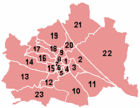 |
| Federal states of Austria | |
|---|---|
| Administrative seats of Austrian provinces | |||
|---|---|---|---|
| Capitals of European states and territories | |||||||||||||||||||||||||||
|---|---|---|---|---|---|---|---|---|---|---|---|---|---|---|---|---|---|---|---|---|---|---|---|---|---|---|---|
| Capitals of dependent territories and states whose sovereignty is disputed shown in italics. | |||||||||||||||||||||||||||
| Sovereign states |
| ||||||||||||||||||||||||||
| States with limited recognition |
| ||||||||||||||||||||||||||
| Dependencies |
| ||||||||||||||||||||||||||
| Federal states |
| ||||||||||||||||||||||||||
| Autonomous entities |
| ||||||||||||||||||||||||||
| |||||||||||||||||||||||||||
| World Heritage Sites in Austria | ||
|---|---|---|
| ||
| ||
| Eurovision Song Contest | |||||||||||||
|---|---|---|---|---|---|---|---|---|---|---|---|---|---|
| Contests |
| ||||||||||||
| Countries |
| ||||||||||||
| National selections |
| ||||||||||||
| Related articles |
| ||||||||||||
| The Danube | ||
|---|---|---|
| Countries |  | |
| Cities | ||
| Tributaries | ||
| Canals | ||
| See also | ||
48°12′N 16°22′E / 48.200°N 16.367°E / 48.200; 16.367
Categories:- Vienna
- Capitals in Europe
- NUTS 2 statistical regions of the European Union
- Populated places established in the 1st millennium BC
- Populated places in Austria
- Populated places on the Danube
- Roman legions' camps in Central Europe
- States of Austria
- Turkish communities outside Turkey
- University towns in Austria
- Wine regions of Austria
- World Heritage Sites in Austria
